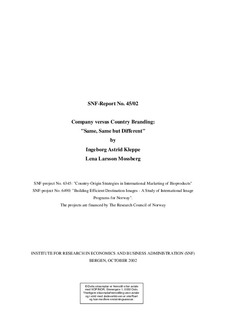| dc.contributor.author | Kleppe, Ingeborg Astrid | |
| dc.contributor.author | Mossberg, Lena Larsson | |
| dc.date.accessioned | 2006-06-28T07:27:33Z | |
| dc.date.available | 2006-06-28T07:27:33Z | |
| dc.date.issued | 2002-10 | |
| dc.identifier.isbn | 82-491-0235-5 (trykt versjon) | |
| dc.identifier.issn | 0803-4036 | |
| dc.identifier.uri | http://hdl.handle.net/11250/164589 | |
| dc.description.abstract | The aim of this study is to investigate whether countries can be branded like companies. Company brands are managed according to clear ownership and top-down control of brand management. In contrast, countries are governed according to the public interest, which requires transparency and participation. A major achievement of rethinking country branding is accomplished through a multinational newspaper content analysis, which enabled us to classify country associations according to variation in relational characteristics between source and target countries. The identified relationship forms - sibling, remote relative, and stranger - have important implications for managerial challenges in country branding with regard to organizational strategies for brand ownership, strategies for customization or standardization of core values across target markets, and communication strategies for country branding. | en |
| dc.format.extent | 192256 bytes | |
| dc.format.mimetype | application/pdf | |
| dc.language.iso | eng | en |
| dc.publisher | SNF | en |
| dc.relation.ispartofseries | Report | en |
| dc.relation.ispartofseries | 2002:45 | en |
| dc.title | Company versus country branding : "Same, same but different" | en |
| dc.type | Research report | en |
